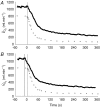Muscular and pulmonary O2 uptake kinetics during moderate- and high-intensity sub-maximal knee-extensor exercise in humans
- PMID: 19255119
- PMCID: PMC2683969
- DOI: 10.1113/jphysiol.2008.166397
Muscular and pulmonary O2 uptake kinetics during moderate- and high-intensity sub-maximal knee-extensor exercise in humans
Abstract
The purpose of this investigation was to determine the contribution of muscle O(2) consumption (mVO2) to pulmonary O(2) uptake (pVO2) during both low-intensity (LI) and high-intensity (HI) knee-extension exercise, and during subsequent recovery, in humans. Seven healthy male subjects (age 20-25 years) completed a series of LI and HI square-wave exercise tests in which mVO2 (direct Fick technique) and pVO2 (indirect calorimetry) were measured simultaneously. The mean blood transit time from the muscle capillaries to the lung (MTTc-l) was also estimated (based on measured blood transit times from femoral artery to vein and vein to artery). The kinetics of mVO2 and pVO2 were modelled using non-linear regression. The time constant (tau) describing the phase II pVO2 kinetics following the onset of exercise was not significantly different from the mean response time (initial time delay + tau) for mVO2 kinetics for LI (30 +/- 3 vs 30 +/- 3 s) but was slightly higher (P < 0.05) for HI (32 +/- 3 vs 29 +/- 4 s); the responses were closely correlated (r = 0.95 and r = 0.95; P < 0.01) for both intensities. In recovery, agreement between the responses was more limited both for LI (36 +/- 4 vs 18 +/- 4 s, P < 0.05; r = -0.01) and HI (33 +/- 3 vs 27 +/- 3 s, P > 0.05; r = -0.40). MTTc-l was approximately 17 s just before exercise and decreased to 12 and 10 s after 5 s of exercise for LI and HI, respectively. These data indicate that the phase II pVO2 kinetics reflect mVO2 kinetics during exercise but not during recovery where caution in data interpretation is advised. Increased mVO2 probably makes a small contribution to during the first 15-20 s of exercise.
Figures









References
-
- Aaron EA, Johnson BD, Seow CK, Dempsey JA. Oxygen cost of exercise hyperpnea: measurement. J Appl Physiol. 1992;72:1810–1817. - PubMed
-
- Andersen P, Adams RP, Sjøgaard G, Thorboe A, Saltin B. Dynamic knee extension as a model for the study of an isolated exercising muscle in man. J Appl Physiol. 1985;59:1647–1653. - PubMed
-
- Bangsbo J, Krustrup P, González-Alonso J, Boushel R, Saltin B. Muscle oxygen uptake kinetics at onset of intense dynamic exercise. Am J Physiol Regul Integr Comp Physiol. 2000;279:R899–R906. - PubMed
Publication types
MeSH terms
LinkOut - more resources
Full Text Sources
Medical

